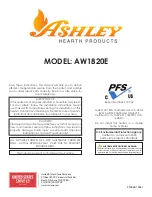
mallet to gently tap it free. Check the baffle
for wear and use a soft wire brush to remove
any soot deposits from both the baffle and
around the flueway. If the baffle needs
replacing a genuine replacement can be
obtained from your authorised Hi-Flame
dealer or from www.hi-flame.co.uk.
Please
note
in line with all stove manufacturers
vermiculite panels, baffle plates and other
internal components are regarded as
consumable items and are therefore not
covered under your Hi-Flame Warranty.
Stove and Chimney Cleaning
This stove can be swept through the fire-
chamber by simply removing its two baffle
plates – see above. The chimney should be
swept before installing the stove and then a
minimum of at least once a year depending
on how often you use the stove – this should
preferably be when you stand down the stove
for the summer.
The amount of soot deposits removed each
time the stove is swept is a good indication of
how often you should sweep the stove and,
as you begin to understand your stove and
the wood you burn, you can then adjust the
cleaning intervals accordingly. If in doubt seek
the advice of a registered chimney sweep who
has experience of sweeping stoves.
Vermiculite Firebricks and Panels
Regularly inspect the condition of the vermiculite
panels used for the firebricks, firebed and
lower baffle plate. Please note that some
minor wear is perfectly normal due to the high
temperatures created inside the stove but
replace any of these if the surface has been
eroded by 20% (approximately 6mm) or if
any damage exposes the stove’s bodywork.
Cracked bricks can still be used providing they
still cover the bodywork.
To replace a firebrick, first remove the lower
baffle plate by pushing this up and then
dropping it down to manoeuvre it out of the
firechamber. There are two loosely fitted side
firebricks, which once the upper baffle has
been removed, should be easy to remove and
this will then release the back firebrick as well
as the firebed panels. They should be returned
in the correct reverse order.
Please note
vermiculite heat reflecting panels are deemed
as ‘consumable’ and are therefore not
covered under your Hi-Flame Warranty.
Heat Resistant Glass Maintenance
Using unseasoned or wet wood, small fuel
loads or operating the stove at low temperatures
(slumber burning) is not recommended and
will reduce the effectiveness of the Airwash
system causing the glass to stain. Do not
allow such staining to build up as it may
become more difficult to remove after each
firing. When used regularly, a proprietary
scratch-resistant stove glass cleaning gel or
spray, which can be supplied by your stove
dealer, should be sufficient to keep the glass
in pristine condition. Make sure the glass is
cold before you apply such cleaners, as applying
a cold solution to hot glass could create a
thermal shock within the glass causing the
glass to crack. Always use a soft cloth to apply
any cleaner. Make sure that all traces of the
cleaning fluid have been removed and that the
glass is thoroughly dry as any residue can be
‘baked’ on causing unsightly smearing.
Never use your stove if it has cracked or missing
glass. Your Hi-Flame dealer can quickly supply
you with a new piece of heat resistant glass
should you ever need it – just let them know
the stove name and model number. Only use
heat-resistant ceramic glass as this is made to
withstand temperatures of up to 800ºC.
Remove the screws and sprung clamp
washers from each corner and place them in a
safe place. Always use the correct sized Phillips
crosshead screwdriver and use releasing oil if
33














































